
A geyser is a spring characterized by an intermittent discharge of water ejected turbulently and accompanied by steam. As a fairly rare phenomenon, the formation of geysers is due to particular hydrogeological conditions that exist only in a few places on Earth. Generally all geyser field sites are located near active volcanic areas, and the geyser effect is due to the proximity of magma. Generally, surface water works its way down to an average depth of around 2,000 metres (6,600 ft) where it contacts hot rocks. The resultant boiling of the pressurized water results in the geyser effect of hot water and steam spraying out of the geyser's surface vent.
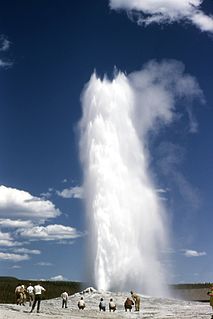
Old Faithful is a cone geyser in Yellowstone National Park in Wyoming, United States. It was named in 1870 during the Washburn–Langford–Doane Expedition and was the first geyser in the park to be named. It is a highly predictable geothermal feature and has erupted every 44 minutes to two hours since 2000. The geyser and the nearby Old Faithful Inn are part of the Old Faithful Historic District.

The geothermal areas of Yellowstone include several geyser basins in Yellowstone National Park as well as other geothermal features such as hot springs, mud pots, and fumaroles. The number of thermal features in Yellowstone is estimated at 10,000. A study that was completed in 2011 found that a total of 1,283 geysers have erupted in Yellowstone, 465 of which are active during an average year. These are distributed among nine geyser basins, with a few geysers found in smaller thermal areas throughout the Park. The number of geysers in each geyser basin are as follows: Upper Geyser Basin (410), Midway Geyser Basin (59), Lower Geyser Basin (283), Norris Geyser Basin (193), West Thumb Geyser Basin (84), Gibbon Geyser Basin (24), Lone Star Geyser Basin (21), Shoshone Geyser Basin (107), Heart Lake Geyser Basin (69), other areas (33). Although famous large geysers like Old Faithful are part of the total, most of Yellowstone's geysers are small, erupting to only a foot or two. The hydrothermal system that supplies the geysers with hot water sits within an ancient active caldera. Many of the thermal features in Yellowstone build up sinter, geyserite, or travertine deposits around and within them.
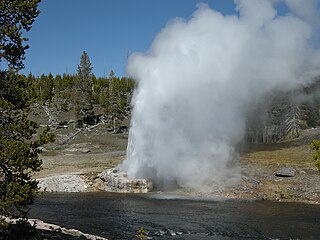
Riverside Geyser is a geyser in Yellowstone National Park in the U.S. state of Wyoming.
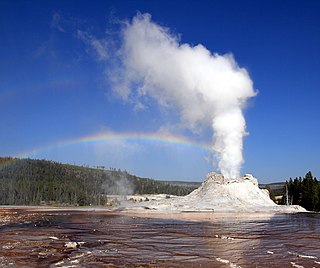
Castle Geyser is a cone geyser in the Upper Geyser Basin of Yellowstone National Park. It is noted for the particularly large geyserite sinter deposits, which form its cone. These deposits have been likened in appearance to a castle.

Grand Geyser is a fountain geyser in the Upper Geyser Basin of Yellowstone National Park in the United States. It is the tallest predictable geyser known. It was named by Ferdinand Vandeveer Hayden in 1871.
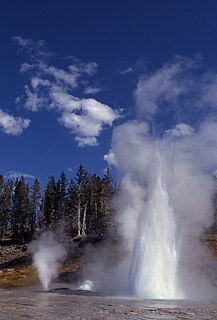
Turban Geyser is a geyser in the Upper Geyser Basin of Yellowstone National Park in the United States.
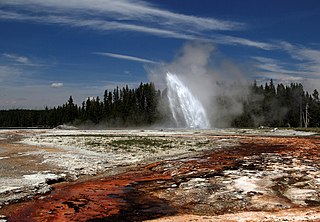
Daisy Geyser is a geyser in the Upper Geyser Basin of Yellowstone National Park in the United States.
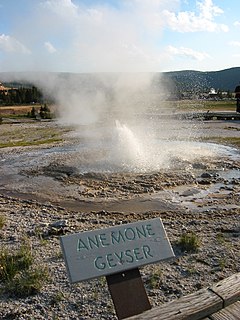
Anemone Geyser is a geyser in the Upper Geyser Basin of Yellowstone National Park in the United States. Anemone is actually two closely related geysers. The larger of the two is known as Big or North Anemone while the smaller is known as Little or South Anemone. The two geysers were named after the anemone flower by the Hague Party in 1904. Both vents have a pale yellow color and shape similar to the flower.
Labial Geyser is a fountain-type geyser in the Lower Geyser Basin of Yellowstone National Park in the United States. It is part of the Pink Cone Group. Other geysers in this groups are Labial's Satellite Geyser, Bead Geyser, Box Spring, Dilemma Geyser, Narcissus Geyser, Pink Geyser, and Pink Cone Geyser.

Excelsior Geyser Crater, formerly known as Excelsior Geyser, is a dormant fountain-type geyser in the Midway Geyser Basin of Yellowstone National Park in the United States. Excelsior was named by the Hayden Geological Survey of 1871.

Beehive Geyser is a geyser in the Upper Geyser Basin of Yellowstone National Park in the United States. The 4-foot (1.2 m) tall cone resembles a straw beehive. Beehive's Indicator is a small, jagged cone-type geyser located about 10 feet (3.0 m) from Beehive.

Fountain Geyser is a geyser in the Lower Geyser Basin of Yellowstone National Park in the United States.
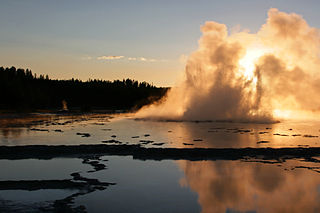
The Great Fountain Geyser is a fountain-type geyser located in the Firehole Lake area of Lower Geyser Basin of Yellowstone National Park, Wyoming. It is the only Lower Geyser Basin feature that the park makes predictions for.

Jet Geyser is a geyser in the Lower Geyser Basin of Yellowstone National Park in the United States. Jet Geyser is in the Fountain Group that includes Fountain Geyser, Morning Geyser, Red Spouter and Silex Spring.
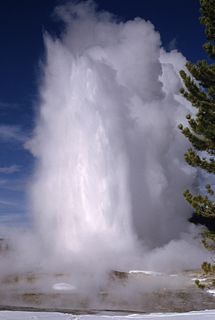
Giant Geyser is a cone-type geyser in the Upper Geyser Basin of Yellowstone National Park in the United States. Giant Geyser is the namesake for the Giant Group of geysers, which, on its platform, includes Bijou Geyser, Catfish Geyser, Mastiff Geyser, the "Platform Vents," and Turtle Geyser. Giant Geyser's Platform, a raised stone structure incorporating all these geysers. Giant is notable for its spectacular, but sporadic eruptions, as well as for its very large cone of geyserite, which stands about 12 feet tall.
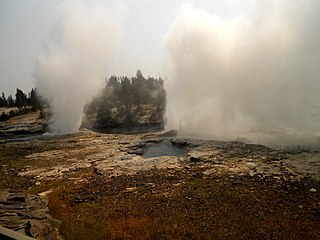
Fan and Mortar Geysers are two geysers in the Upper Geyser Basin in Yellowstone National Park. For the past several decades, they have erupted in concert with one another and are generally talked about together. The records detailing these geysers' known eruptive history shows that they have been infrequent and irregular performers.

The following articles relate to the history, geography, geology, flora, fauna, structures and recreation in Yellowstone National Park.

White Dome Geyser is a geyser located in the Lower Geyser Basin in Yellowstone National Park in the United States.

Giantess Geyser is a fountain-type geyser in the Upper Geyser Basin of Yellowstone National Park. It is known for its violent and infrequent eruptions of multiple water bursts that reach from 100 to 200 feet. Eruptions generally occur 2 to 6 times a year. The surrounding area may shake from underground steam explosions just before the initial water and/or steam eruptions. Eruptions may occur twice hourly, experience a tremendous steam phase, and continue activity for 4 to 48 hours. The Geyser last erupted on August 26, 2020 after a six year, 210 day hiatus. A follow up eruption occurred 15 days later on 10 September 2020. Another eruption occurred on 11 August 2021




















